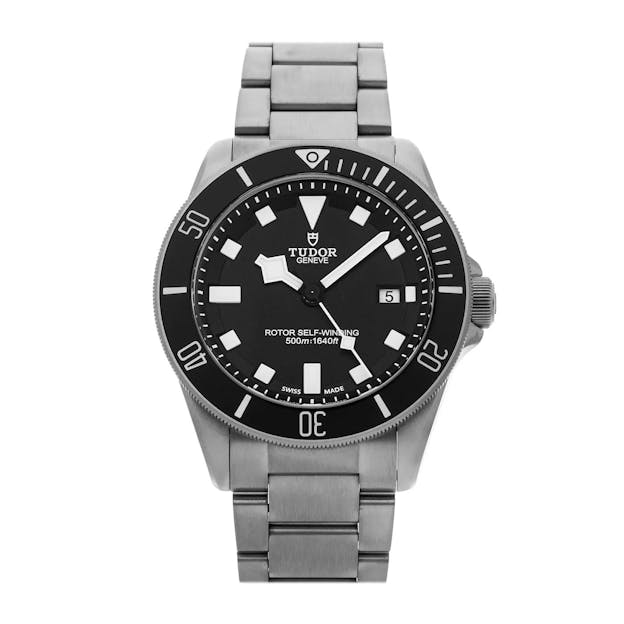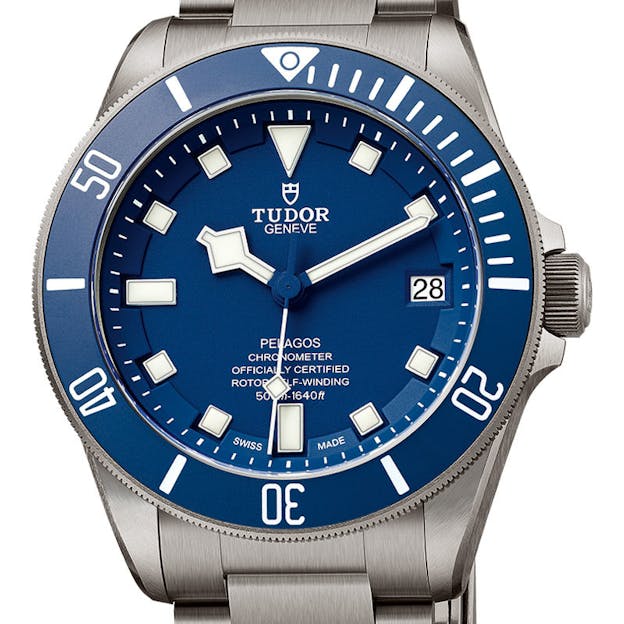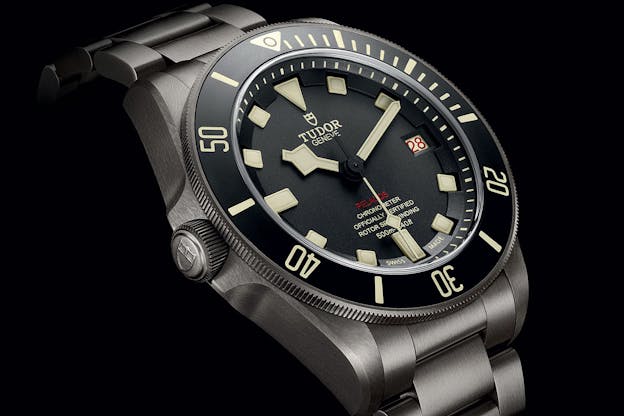The Tudor Pelagos: A Guide To Tudor’s Technical Diver And Its Variants
Tudor’s saturation diver, diversified.
The Tudor Pelagos was first released by Tudor in 2012, and it represents Tudor’s approach to dive watches in particular, and sports watches in general, from a modern design and technology perspective. Generally, the Pelagos watches rely on high tech case materials like titanium and, more recently, carbon composites, and except for the first version of the 500M Pelagos, all use Tudor in-house movements, with silicon balance springs, freesprung balances, and a 70 hour power reserve. Since the release of the first Pelagos, a second major sub-family has been added. This is the Tudor FXD family, which in its original version is a highly unusual watch with a very specific mission, which is to aid in underwater dead reckoning navigation. This year, Tudor released the latest Pelagos – the FXD Cycling Edition – and we thought it was a timely occasion to take a look back at the history of the Pelagos watches, and how the different models break down. While all Pelagos models share a common design language, each model has is own specific differentiating features.
The Tudor Pelagos
Original Tudor Pelagos 2012, And 2nd Gen Model
The first Tudor Pelagos model was released in 2012, and remains in the catalog albeit in a different form, a dozen years later. This is the version that established the basic Pelagos design language and, unlike the Black Bay models, which usually have some design elements that directly refer to vintage models, the Pelagos looks and feels entirely modern, with the exception of the snowflake hands. The OG Pelagos by contrast is a modern, technical dive watch, ISO 6425 compliant, and is also compliant with the additional stipulations in the standard for saturation and mixed gas diving. The 42mm case is titanium, with a steel caseback, and the depth rating is 500M, which is of course well beyond the limits of recreational SCUBA. Saturation divers can work as deep as 500 meters, although usually, working dives take place at shallower depths.

This reference, 25500TN, used an ETA movement, the ETA 2824, modified by Tudor (the modifications included Tudor’s own finishing to the main plate, bridges, ratchet wheel, and screw heads, and the use of a Kif anti-shock system for balance pivots, as well as modifications to the escape wheel teeth and pallet fork to produce greater rate stability). The bracelet was a major innovation – it can be adjusted to three different positions, without tools, and the clasp has an internal, spring-loaded self-adjusting system that allows it to expand and contract while on the wrist, giving you the sturdiness of a conventional solid bracelet with the comfort of an expansion bracelet.

The second generation was introduced in 2015, and here there were a number of major modifications. The first was the movement – in the same year, Tudor launched the now discontinued North Flag, which was another modern, technical watch with caliber MT5621, Tudor’s first in-house movement. The second generation Pelagos models were launched with a variation, caliber MT5612, without the power reserve indication.

Significantly, the two calibers were the first Tudor movements to be chronometer certified by the COSC. Design-wise, the first and second-gen Pelagos are almost identical, although there are differences here as well – the original’s dial text is fairly minimal, reading ROTOR SELF WINDING 500m 1640ft, while the new model adds above that, PELAGOS CERTIFIED CHRONOMETER. The second-gen model also eliminates the original’s half-lume plot at 3:00. Case dimensions today are 42mm x 14.3mm, and both first and second-gen models have ceramic bezels with luminous numerals.
The Tudor Pelagos LHD
The Tudor Pelagos LHD was announced in 2016, and the name pretty much says it all – LHD stands for “Left Hand Drive,” referring to the fact that the crown on this model is on the left side of the case. The rationale for this placement can be found in Tudor’s history of making diver’s watches for the French Navy (Marine Nationale) in the 1970s. These watches, references 9401 and 9411, had snowflake hands and conventional right-side crowns, but a few watches were modified for left-handed divers and the crown left models were meant to be worn on the right wrist of a lefty diver.

Other than the left-side crown, there are a couple of other interesting points to note. The first is that unlike the original, PELAGOS on the dial is in red letters in the LHD models. The second is that unlike any other Pelagos model, the casebacks are sequentially numbered. Finally, in a nod to the now-vintage French Navy models, the lume is very lightly tinted, although the aged lume effect is very subtle, and would be easy to miss unless you knew to look for it.
The Tudor Pelagos 39
In 2022, Tudor released a version of the Pelagos which was slightly smaller, and slightly slimmer, and in keeping with the pragmatic nature of the watch, the new 39mm watch got a very pragmatic name – it’s the Tudor Pelagos 39. The Pelagos 39 has a 39mm x 11.8mm titanium case, and unlike the preceding models, it is not certified for saturation diving or mixed gas diving, although it is still fully ISO 6425 compliant, with a water resistance of 200M, a one-way bezel with ceramic insert, and a titanium case.
The Pelagos 39 does not have the self-adjusting folding clasp of the preceding models, although it does have a 25mm wetsuit extension. Also absent is the distinctive cut-out rehaut of the earlier models.
Overall, the Pelagos 39, while not as highly technical as the saturation diving models, is a more versatile watch, with more than enough water resistance, high legibility, and ease of handling to make it suitable for any environment in or out of the water, up to and including any possible recreational SCUBA scenario. 
As with the LHD, the Pelagos 39 has PELAGOS in red, and in a nod to purists who often prefer it to be absent, there’s no date window. The movement is the in-house MT5612.
In the current catalog, the Pelagos is represented by the second-gen models with either a blue or black dial; the Pelagos LHD, and the Pelagos 39.
The Tudor Pelagos FXD
The Tudor Pelagos models represent the second major group of Pelagos models, other than the main collection Pelagos diver’s watches. They were originally created as the result of a renewed partnership with the French Marine National, and are specifically designed for use in underwater navigation by dead reckoning.
The Tudor Pelagos FXD.
The first Tudor FXD watch was introduced by Tudor in 2021, and it represented then, and still represents, a major departure from business as usual for the Pelagos, and indeed, for Tudor diver’s watches in general. The FXD gets its name from its use of FiXeD strap bars, rather than standard spring bars, which provide a more secure connection between the case and the strap. This feature as well as the other highly specific features of the FXD were developed in partnership with the French Navy – specifically, with Commando Hubert, an elite combat diving unit, originally organized in 1953 and named for Lieutenant Augustin Hubert, who was killed near Sword Beach during the first hours of Operation Overlord, in 1944 (the French Commando Marine units are named for officers killed in action).

The Pelagos FXD has a 42mm x 12.75mm matte finish titanium case, 200M water resistance, and matte finish blue dial, as well as a blue ceramic bezel. The bezel is probably the biggest distinguishing feature of the FXD – it is not a count-up, or elapsed time bezel, the type found on all diver’s watches as specified by ISO 6425. Instead, it is a count-down bezel, which shows the time remaining in a chosen time interval. To use the bezel, the wearer rotates the bezel until the desired time interval is adjacent to the tip of the minute hand. The minute hand will then, as it continues to turn, show the amount of time remaining in the elapsed time interval chosen.
There are a couple of interesting points to note, the first of which is that although this watch was designed with combat swimmers in mind, it is not, at least by the letter of the law, a “dive watch” as ISO 6425 specifies a one way elapsed time bezel. This is a mere technicality and more a curiosity than anything else, as in practical terms the FXD is certainly more than capable in terms of underwater utility. The second point is the rationale for a countdown bezel. The countdown bezel is designed to be used for navigation underwater. When navigating between two waypoints, the time from one waypoint to the next is specified and divers should reach each waypoint within a specific time interval; directional bearings are taken from a magnetic compass.

The caseback has an engraving which commemorates the date of the renewed partnership, as well as the date of the founding of the French Navy as the Marine Royale, in 1626, during the reign of Louis XIII.

It’s an extremely interesting watch both technically and in terms of its reflection of Tudor’s relationship with the French Navy’s commando diver’s units – a highly specific watch made for a highly specific task, and therein lies its appeal. The movement is the in-house caliber MT5602, no date, with a 70 hour power reserve.
The Tudor Pelagos FXD, 2023, US Navy
Tudor has also supplied watches in the past to the US Navy – most notably, Tudor watches were used by the US Navy SEAL teams, from 1962 all the way into the 1980s. This 2023 release is not a commemorative edition per se, although it is inspired by the dive watches used by the Navy during the era when Tudor was a supplier. Unlike the first FXD, which was specifically designed for underwater dead-reckoning navigation, the 2023 Pelagos is designed as a highly robust, durable, more general purpose dive watch.

A moment’s close observation will reveal the single biggest difference between the original FXD and the 2023 model – the new version has a standard, unidirectional elapsed time bezel, and is therefore compliant with the ISO 6425 standard. As with the original FXD, there are no spring bars – the strap bars are machined as an integral part of the case.

The dial and bezel are both matte black, and dimensions are the same as the original FXD – 42mm x 12.75mm. The movement is the same as well – MT5602, chronometer certified, with silicon balance spring, freesprung balance, and 70 hour power reserve.
The Pelagos FXD And FXD Chronograph X Alinghi Red Bull Racing Editions
It might surprise you to hear that landlocked Switzerland competes for the America’s Cup, but the Swiss definitely have a contender in Team Alinghi, which was established in 1994 and which won the Cup, not once, but twice, in 2003 and 2007. The FXD Team Alinghi models were created in partnership with the team and have design features which reflect the team livery, as well as the construction of the Alinghi racing yachts – high speed hydrofoils with carbon fiber hulls – and the specific conditions at the start of the race. The watches were introduced in time-only and chronograph models.

Both watches have cases made of carbon fiber, and both have ceramic bezel inserts, as well as red, black, and blue colors which reflect the official colors of the team. The watches are both certified chronometers, with PELAGOS in red on the dial, as well as a red snowflake seconds hand for the time-only model, and a red chronograph seconds hand for the chronograph.

Both watches have the countdown bezel of the original FXD. In yacht racing, counting down to the start of the race is one of the most critical elements skippers and crews have to manage. Yachts, unlike cars, cannot wait motionless at the starting line until a signal is given to begin the race. Instead, yachts must maneuver back and forth as close to the line as possible, until the starting signal is given and the competing vessels are allowed to cross. A countdown timer is therefore useful in helping competing teams stay oriented to approximately how much time is left before they can cross the line and begin the race proper.
One among several interesting features of the chronograph, is that it has a countdown bezel, but also a count up/elapsed time feature in the chronograph proper. The chronograph can time elapsed time intervals of up to 45 minutes.

The two watches are nearly identical in size – 42mm for the time only model, and 43mm for the chronograph – and both feature the fixed strap bars that are a signature design element for the FXD Pelagos models. Movements are both Tudor in house, with silicon balance springs and freesprung balances – caliber MT5602 for the time only model, and caliber MT5813, with column wheel and vertical clutch (this is the same movement Tudor uses in the Black Bay Chronograph).
The Pelagos FXD Chrono, Cycling Edition
Tudor sponsors the Tudor Pro Cycling professional racing team, which was launched in 2022 and which has 41 riders from 11 nations, including 11 Swiss. The Cycling Edition Chronograph shares the physical dimensions and case material of the Alinghi chronograph model – 43mm carbon composite, for lightness, since every gram counts in bike racing – and uses the same movement, caliber MT 5813.

Where the two watches differ, is in the Cycling Edition’s tachymetric scale, which is printed on the rehaut.

Tachymetric scales on many chronographs, such as the Omega Speedmaster, are calibrated to show speed over distance, in miles per hour; generally the scale is set up to measure speeds from 500 mph to 60 mph – obviously, 500 mph is well above the speed you’ll hit no matter how light your bike and massive your thighs. The tachymeter bezel on the Cycling Edition can measure very high speeds of up to 240 mph, but the watch also uses a three ring tachymeter scale to allow speeds as low as 20 mph to be measured. The outermost scale bottoms out at 60 mph; the second at 30 mph, and the innermost, at 20 mph.
The Pelagos models, across the board, represent watches which as a rule are made with specific technical features for specific use cases, although those obviously do not preclude more general applications of those features (an elapsed time bezel, for instance, as found in the FXD, has many obvious other uses than dead reckoning underwater). Their practicality, and class-leading engineering, also gives them their own aesthetic – a no-nonsense dignity that becomes a design feature in its own right.
For more, view our new and pre-owned Tudor Pelagos models at The 1916 Company.

